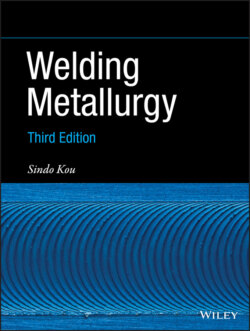Читать книгу Welding Metallurgy - Sindo Kou - Страница 92
3.2 Effect of Metal Vapor on Arcs 3.2.1 Gas−Tungsten Arc Welding
ОглавлениеTanaka et al. [7] showed that Fe vapor can significantly increase the electrical conductivity of the welding arc. As can be expected, the electrical conductivity of He is lower than that of Ar because He has a significantly higher ionization energy than Ar (Table 1.2). That is, He is more difficult to dissociate into electrons and positive ions to help conduct the welding current as explained in Chapter 1. Figure 3.8 shows that He has lower conductivity than Ar, and also shows that the Fe vapor can significantly increase the electrical conductivity of both Ar and He at lower temperatures. The distributions of temperature and Fe vapor were calculated for stationary arcs over 304 stainless steel at 150 A current and 5 mm arc length. They showed significantly more Fe vapor in the He arc than the Ar arc. After welding for 20 seconds, much Fe vapor deposit appeared around the He weld but little around the Ar weld, as shown in Figure 3.9. Without considering the Fe vapor, the calculated current density at the pool surface is too high and the calculated weld too deep.
Figure 3.8 Electrical conductivity of Ar and He and how they are affected by Fe vapor.
Source: Tanaka et al. [7]. © IOP Publishing.
Figure 3.9 304 stainless steel welded by stationary gas‐tungsten arc for 20 s: (a) He as shielding gas, showing much Fe vapor deposit; (b) Ar as shielding gas, showing little Fe vapor deposit; (c) cross‐section of weld made with He shielding.
Source: Tanaka et al. [7]. © IOP Publishing.
Kodama et al. [8] studied metal evaporation and its effect on nitrogen absorption in GTAW of steel. Figure 3.10 shows the calculated distributions of temperature and Fe vapor in gas‐tungsten welding arcs (150 A current and 5 mm arc length) with Ar shielding and with He shielding. With He the electrical resistance to the welding current is higher, the arc is warmer, the weld pool surface is warmer, and Fe evaporation is more significant. The calculated maximum pool surface temperature is 2870 K for the He arc and 2450 K for the Ar arc. Although the He arc is warmer as a whole, it is cooler immediately (0.1 mm) above the pool surface (5900 K) because the Fe vapor there helps it conduct the welding current. Thus, as compared to a shielding gas of Ar + 1% N2, with He + 1% N2, nitrogen dissociation (N2 → 2N) in the arc near the pool surface and hence N dissolution in the pool (denoted as N) may be expected to be less significant. This was used to explain why nitrogen porosity is observed in a steel made by GTAW with Ar + 1% N2 but not with He + 1% N2.
Figure 3.10 Computer simulation of gas‐tungsten arcs considering metal evaporation from pool: (a) (b) Ar arc; (c) 1% N2 in Ar causing porosity; (d) (e) He arc. (f) 1% N2 in He causing no porosity.
Source: Kodama et al. [8]. Springer Open Access.
